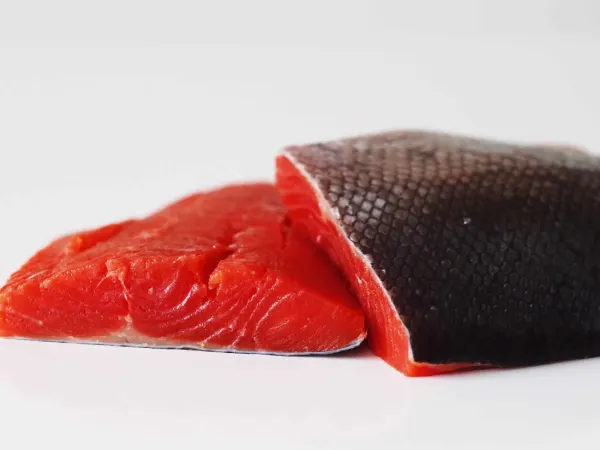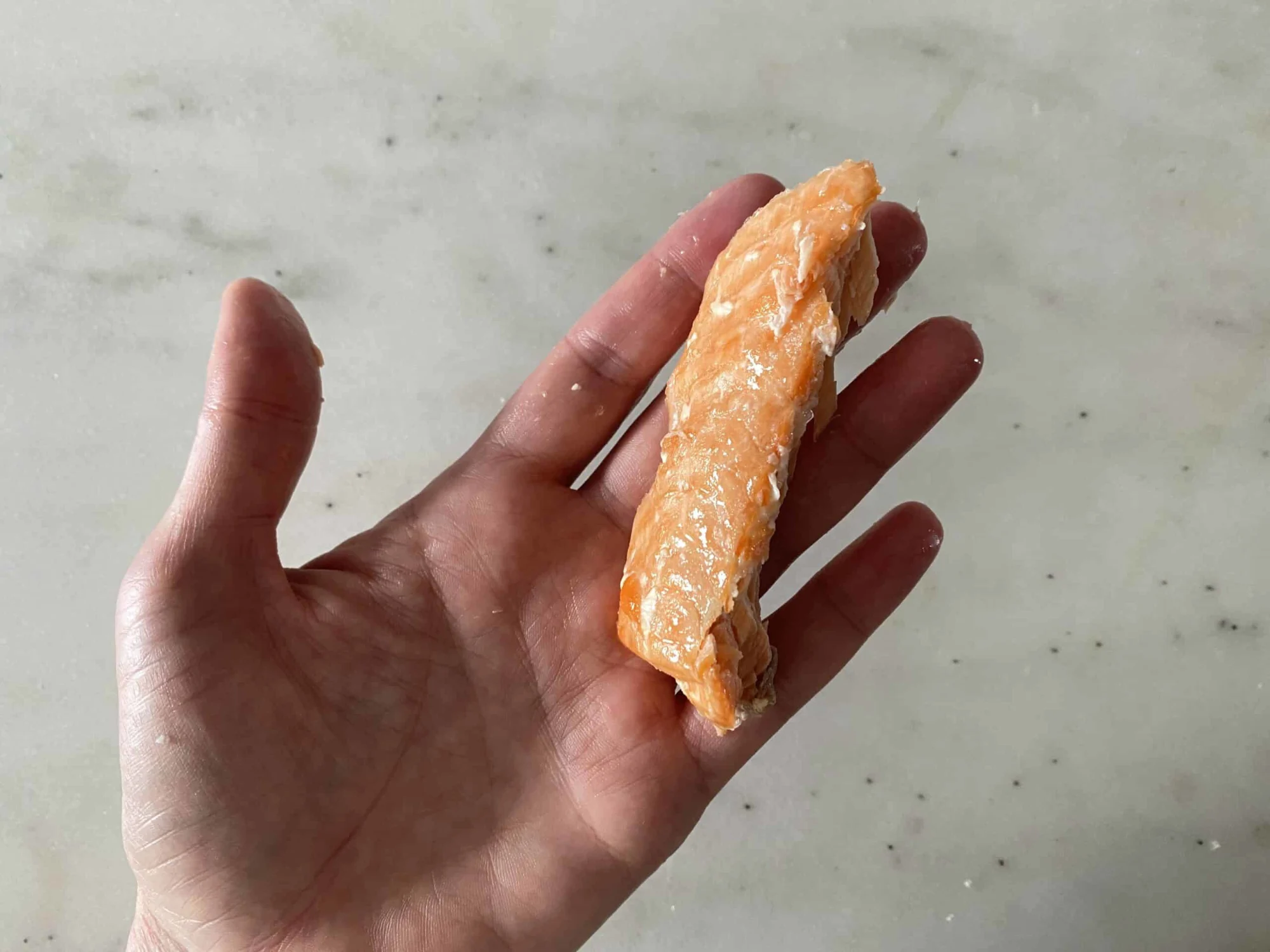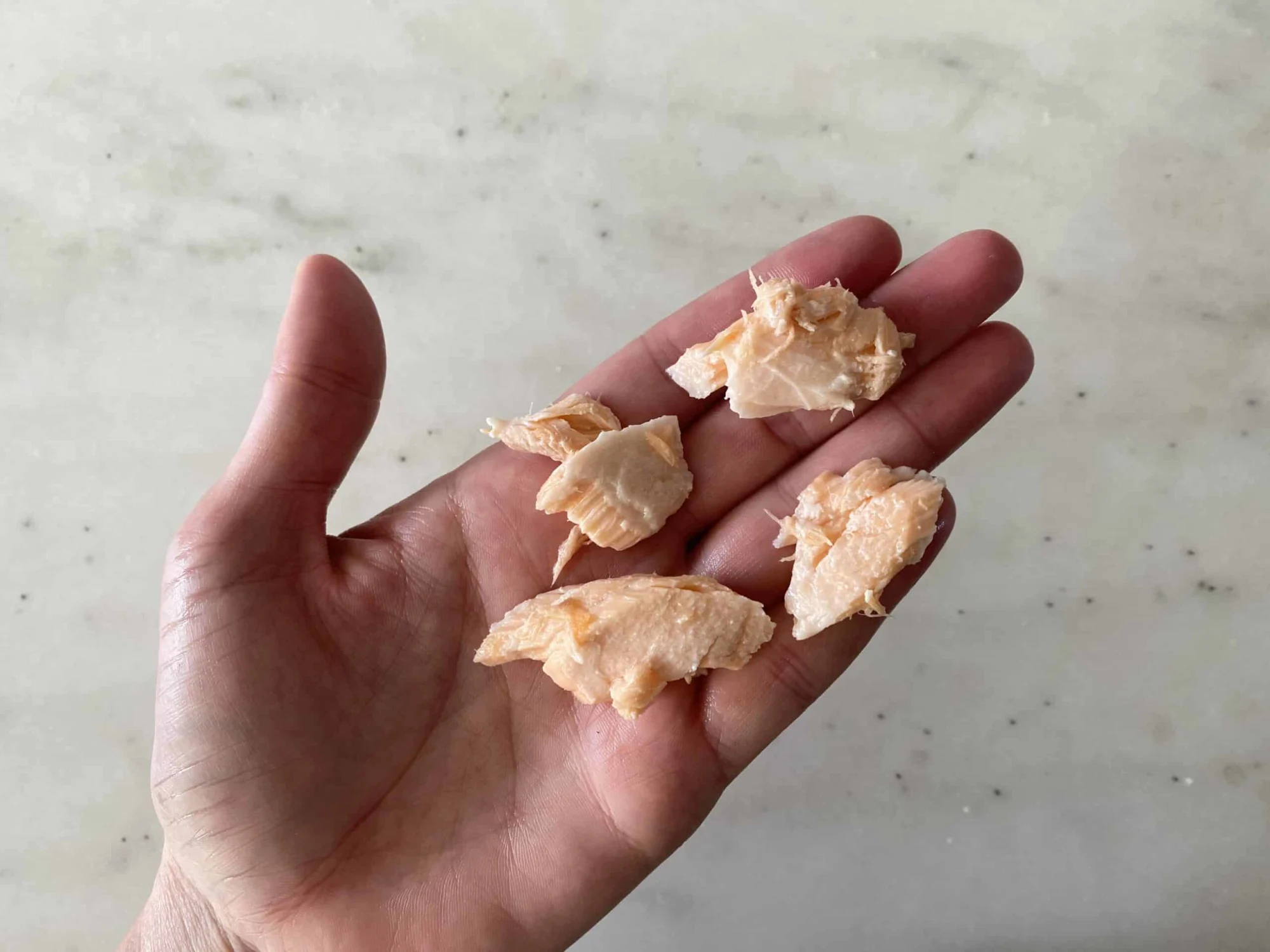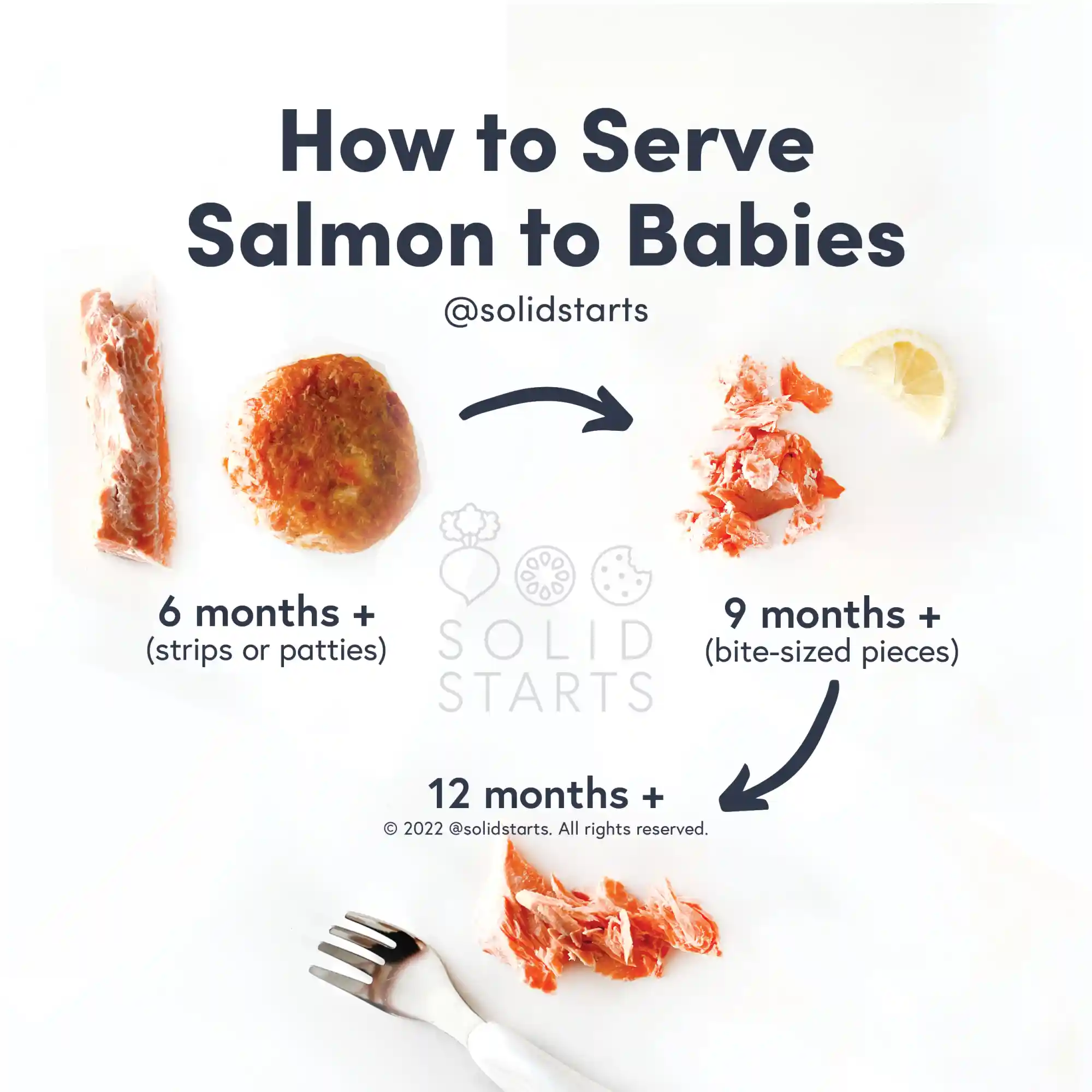Salmon
Fish (Finned)
Age Suggestion
6 months
Iron-Rich
Yes
Common Allergen
Yes

When can babies have salmon?
Salmon may be introduced as soon as baby is ready to start solids, which is generally around 6 months of age. Compared with other fish, salmon tends to be low in mercury.
Salmon are a family of fish closely related to char and trout that live in fresh and salt waters throughout the northern hemisphere. Many wild salmon live their adult years in the ocean, but return to the freshwater rivers of their birth to lay eggs. Salmon are also produced on aquaculture farms worldwide.
Is salmon healthy for babies?
Yes. Salmon is rich in protein and fat, in addition to iodine, iron, potassium, selenium, and zinc. It also offers good amounts of vitamins A, B6, B12, D, and folate. These nutrients work together to support growth, neurodevelopment, energy levels, immunity, vision, bone density, and more. Salmon contains omega-3 fatty acids, including DHA, which supports visual health and cognitive development. There are a wide variety of salmon to choose from, such as wild Alaskan salmon, sockeye salmon, freshwater New Zealand salmon, and farmed Atlantic salmon, in addition to other salmon worldwide.
Is salmon high in mercury?
No. Salmon tends to be low in mercury, although this can vary based on where the fish lived and what it ate. Mercury is a heavy metal that is present in most fish and shellfish to varying degrees and, when consumed in excess, can negatively impact a child’s neurodevelopment. That said, babies who are allowed to self-feed generally do not eat excessive amounts of any one food as they build the skills to eat solids. To minimize baby’s exposure to mercury from fish, serve fish as part of a balanced diet and, when possible, choose fish that are low in mercury, like salmon, sardines, or North Atlantic mackerel.
Is salmon a common allergen?
Yes. Finned fish are classified as a Global Priority Allergen by the World Health Organization. Salmon is among the most common finned fish allergens, along with cod, halibut, and tuna. It is estimated that only 0.2% of people are allergic to finned fish worldwide, and the prevalence of fish allergies in children, while variable, is even less than in adults. About 40% of people with finned fish allergies don’t experience their first allergic reaction until adulthood. Unfortunately, most individuals who are allergic to finned fish do not outgrow the allergy.
Some individuals with finned fish allergy may react from inhaling airborne proteins that are aerosolized when cooking fish. If this is the case for baby, you may wish to avoid cooking fish in the household when baby is present.
Around 50% of individuals with one finned fish allergy will react to another fish as well. This is because the major allergen in finned fish, beta-parvalbumin, is present in most fish, regardless of species. Due to the risks of cross-contamination or mislabeling, allergists often recommend that those allergic to one species of finned fish avoid all finned fish until meeting with an allergist to determine which fish might be safely introduced into the diet. This is an individualized recommendation, so be sure to confirm with your allergist before offering other finned fish if baby is allergic to salmon.
Finned fish are a known trigger of food protein-induced enterocolitis syndrome, also known as FPIES. FPIES is a delayed allergy to food protein which causes the sudden onset of repetitive vomiting and diarrhea to begin a few hours after ingestion. Left untreated, the reaction can result in significant dehydration. Unlike other food allergens, FPIES to finned fish may not present until later in life, and tends to be life-long.
Lastly, a note on scombroid poisoning, which is sometimes mistaken for a fish allergy. Scombroid poisoning is a type of food poisoning that occurs when someone eats fish that has been improperly refrigerated. This allows a large amount of histamine to build up in the fish. When consumed, this large load of histamine can cause symptoms that mimic those of an allergic reaction, causing some people to believe that they have developed a finned fish allergy, even if they are not allergic. Ensuring that fish has been stored at adequately cool temperatures can minimize the risk of such a reaction.
If you suspect baby may be allergic to fish, consult an allergist before introducing salmon. As with all common allergens, introduce salmon in small amounts at first and watch closely as baby eats to see if any adverse reaction occurs. If all goes well, gradually increase the serving size over time. Once common food allergens are successfully introduced, it is recommended to keep them in the diet regularly (twice weekly, if possible). However, this doesn’t mean that each different fish species must be offered multiple times a week. Finned fish share the same major proteins, so it is perfectly acceptable to rotate finned fish varieties according to availability and preference.
Is salmon a choking hazard for babies?
No, though bones in freshly cooked fish are a choking hazard if not removed. To reduce the risk, remove the bones from cooked fish, and prepare and serve salmon in an age-appropriate way. As always, make sure you create a safe eating environment and stay within an arm’s reach of baby during meals.
Learn the signs of choking and gagging and more about choking first aid in our free guides, Infant Rescue and Toddler Rescue.
Videos
Can babies have canned salmon?
Yes, canned salmon is fine to share with babies as soon as they are ready for solids. If you would like to reduce sodium in baby’s food, draining and rinsing the fish under running water can reduce the sodium levels, but doing this is not necessary. Learn more about sodium and babies on our Sodium FAQ page.
Is wild-caught salmon better than farmed salmon?
No, neither is better than the other, although one may better fit your family’s needs. Both types of salmon are nutritious and offer benefits.
From a nutritional standpoint, wild Alaskan salmon is rich in nutrients and can offer higher levels of omega-3 fatty acids but it can also be a bit higher in environmental contaminants from the ocean than farmed fish. In terms of price and accessibility, farmed salmon often have the advantage over the wild-caught fish. Because they are raised year-round, they are widely available and typically more affordable. Farmed salmon may have reduced concentrations of certain nutrients, like omega-3 fatty acids, when compared to wild salmon.
How much salmon can babies eat?
If desired, serve salmon up to a few times per week, but try not to worry about exact amounts. During any given meal, a baby may eat lots of salmon, or may eat very little, and both scenarios are fine when salmon is one part of a variety of foods in the diet.
When can babies eat smoked salmon?
If the smoked salmon is fully cooked, you can offer a taste here and there as soon as baby is ready for solids. Smoked salmon products that are not fully cooked (such as cold-smoked salmon) pose an increased risk of foodborne illness for babies, whose immune systems are still developing. For these, there is no definitively safe age to introduce; rather, it is a personal decision for which you must calculate risk. Lastly, all types of smoked salmon contain high sodium levels, so consider serving in moderation since baby does not need much added sodium at this age.
When can babies eat salmon sushi?
There is no age at which eating raw salmon is without risk, so whether or when to serve it is a personal decision for which you must make an informed decision in the context of your child. Raw salmon poses a high risk of foodborne illness, especially salmonellosis and vibriosis, which are harmful bacterial infections for babies, children, and adults alike, with more risk of severe symptoms in babies. Cooking finned fish and shellfish to an internal temperature of 145 F (63 C) helps to kill concerning bacteria in the food.
How do you serve salmon to babies?
Every baby develops on their own timeline, and the suggestions on how to cut or prepare particular foods are generalizations for a broad audience.
6 months old +:
Offer strips of freshly cooked salmon (all bones and skin removed) about the size of two adult fingers pressed together, or flake the fish and mix into other soft, scoopable foods. Alternatively, mix canned salmon into mashed potatoes, yogurt, or another soft food for baby to scoop. At this age, you can also offer fish cakes made from salmon, as long as they are soft and larger than baby’s mouth.
9 months old +:
Offer bite-sized pieces of canned or freshly cooked salmon (all bones and skin removed); cakes and patties; or salmon salad. You can also continue to serve longer strips of cooked salmon (all bones and skin removed) for biting and tearing practice. To make salmon salad, just mix the flakes with mashed avocado, mayonnaise, olive oil, or yogurt.
12 months old +:
Serve cooked, deboned fish in longer strips, bite-sized pieces, cakes and patties, or flakes on its own or mixed into other foods. This is a great age to work on utensil practice with foods like salmon. Lastly, feel free to introduce fully-cooked versions of smoked salmon, lox, gravlax, or pickled salmon in moderation.


For more information on which fish are safe for babies, see our guide to the Best and Worst Fish for Babies.
Written by
Expert Tips Delivered to Your Inbox
Sign up for weekly tips, recipes and more!
The content offered on SolidStarts.com is for informational purposes only. Solidstarts is not engaged in rendering professional advice, whether medical or otherwise, to individual users or their children or families. No content on this site, regardless of date, should ever be used as a substitute for direct medical advice from your doctor or your medical or health professional, nutritionist, or expert in pediatric feeding and eating. By accessing the content on SolidStarts.com, you acknowledge and agree that you are accepting the responsibility for your child’s health and well-being. In return for providing you with an array of content “baby-led weaning” information, you waive any claims that you or your child may have as a result of utilizing the content on SolidStarts.com.








